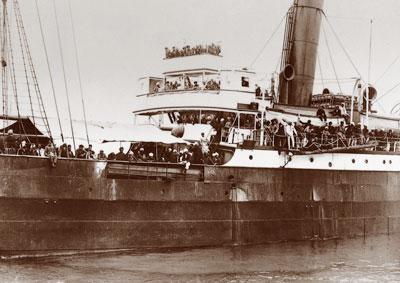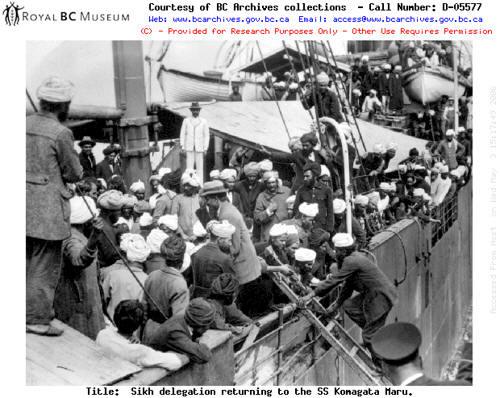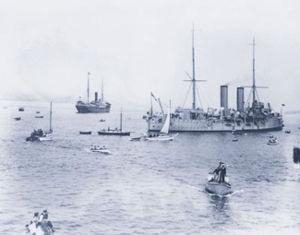| Komagata
Maru- Most notorious incident in history |
|
 |
20th century exclusion
laws in Canada and the United States designed to keep out immigrants
of Asian origin. Most notorious incident in history:
Gurdit Singh from Amritsar, a well-to-do fisherman in Singapore
wanted to circumvent these laws by hiring a boat to sail from
Calcutta to Vancouver. In chartering the Komagata Maru, Gurdit
Singh's goal was to challenge the continuous journey regulation
and open the door for immigration from India to Canada.
In 1914, he hired a Japanese steam liner called "The Komagata
Maru" that was sailed from Hong Kong to Shanghai, China,
Japan, and then to Vancouver, British Columbia, Canada, carrying
376 passengers from Punjab, India. The passengers consisted of
340 Sikhs, 24 Muslims, and 12 Hindus, and all were British subjects.
The passengers were not allowed to land in Canada and the ship
was forced to return to India.
"White Canada" policy:
In the start of the 20th century:
- Canada passed several bills:
- Limiting the civil rights of Indians, including the right
to vote, hold public office, serve on juries, or practice
as pharmacists, lawyers, and accountants.
- India, like Canada, was part of the British Empire, Canadian
authorities did not pass exclusion laws explicitly targeting
those of Indian origin.
- The Imperial authorities in London had noted Indian resentment
when the White Australia policy was put in place in 1905; this
policy was in turn adopted by New Zealand.
When Canada started making provisions to block immigration from
India, London warned it to be cautious in its approach and to
be aware that its actions might inflame nationalist fervour in
India.With this in mind, Canadian immigration authorities devised
an ingenious plan to indirectly halt Indian immigration to
the country.
Canadian New Law- immigrants had to come by
"continuous journey" from their country of birth and
enter with at least $200 cash:
- To be admitted into Canada, immigrants had to come by "continuous
journey" from their country of birth and enter with at
least $200 cash on their persons.
- The continuous journey regulation did not mention race or
nationality and on the surface seemed fair and applicable to
all immigrants. It was, however, an open secret that the regulation
was to apply only to Indians.
- Canadian Pacific did run a very lucrative shipping line between
Vancouver and Calcutta. However, the Canadian government forced
the company to stop this service. It was now impossible to come
via continuous journey to Canada.
This was one of many hidden measures that Canada undertook
to enforce a hidden "White Canada" policy.
To put these measures in context, restrictions on Asian immigration
were being enacted at a time when Canada was accepting massive
numbers of European immigrants over 400,000 in 1913 alone.
The Komagata Maru:
Hong Kong became the point of departure. The ship was scheduled
to leave in March:
- Gurdit Singh was arrested for selling tickets for an illegal
voyage. He was later released on bail and given permission by
the Governor of Hong Kong to set sail.
- The ship departed on April 4 with 165 passengers.
- More passengers joined at Shanghai on April 8, and the ship
arrived at Yokohama on April 14.
- It left Yokohama on May 3 with its complement of 376 passengers,
and sailed into Burrard Inlet, near Vancouver, on May 23.
- This ship belongs to the whole of India, this is a symbol
of the honour of India and if this was detained, there would
be mutiny in the armies" a passenger told a British officer.
- The Indian Nationalist revolutionaries Barkatullah and Balwant
Singh met with the ship en route. Balwant Singh was head priest
of the Gurdwara in Vancouver and had been one of three delegates
sent to London and India to represent the case of Indians in
Canada. Ghadarite literature was disseminated on board and political
meetings took place on board.
Komagata Maru arrived in Canadian waters, it was not allowed
to dock:
On May 23, the Komagata Maru arrived in Canadian waters, it
was not allowed to dock.
- The Conservative Premier of British Columbia, Richard McBride,
gave a categorical statement that the passengers would not be
allowed to disembark.
- Komagata Maru was escorted by the HMCS Rainbow and a swarm
of small boats.
- Meanwhile a "shore committee" had been formed with
Hussain Rahim and Sohan Lal Pathak. Protest meetings were held
in Canada and the USA. At one, held in Dominion Hall, Vancouver,
it was resolved that if the passengers were not allowed off,
Indo-Canadians should follow them back to India to start a rebellion
(or Ghadar). The shore committee raised $22,000 as an installment
on chartering the ship.
- They also launched a test case legal battle in the name of
Munshi Singh, one of the passengers.
- On July 7, the full bench of the Supreme Court gave a unanimous
judgement that under new Orders-In-Council, it had no authority
to interfere with the decisions of the Department of Immigration
and Colonization.
- The Japanese captain was relieved of duty by the angry passengers,
but the Canadian government ordered the harbour tug Sea Lion
to push the ship out to sea.
- On July 19, the angry passengers mounted an attack. The next
day the Vancouver newspaper, The Sun reported: "Howling
masses of Hindus showered policemen with lumps of coal and bricks...
it was like standing underneath a coal chute".
- The government also mobilised the HMCS Rainbow, a former Royal
Navy ship under the command of Commander Hose, with troops from
the Royal Irish Fusiliers, 72nd Highlanders, and the 6th DCOR
regiments.
- At the end, only 24 passengers were admitted to Canada, since
the ship had violated the exclusion laws, the passengers did
not have the required funds, and they had not sailed directly
from India. The ship was turned around and forced to depart
on July 23 for Asia.
The Komagata Maru arrived in Calcutta on September 26:
- A British gunboat forced the ship to stop and the passengers
were placed under guard.
- The ship was then diverted approximately 17 miles to Budge
Budge, where the British intended to put the group on a train
bound for Punjab.
- The passengers wanted to stay in Calcutta and marched on the
city, but were forced to return to Budge Budge and reboard the
ship.
- The passengers protested, with some refusing to reboard, and
the police opened fire, killing 20 and wounding nine others.
This incident became known as the Budge Budge Riot.
Gurdit Singh managed to escape and lived in hiding until 1922.
He was urged by Mahatma Gandhi to give himself up as a true patriot;
he duly did so, and was imprisoned for five years.
The Ghadar Party
The Komagata Maru incident was widely cited at the time by Indian
groups to highlight discrepancies in Canadian immigration laws.
Further, the inflamed passions in the wake of the incident were
widely cultivated by the Indian revolutionary organisation, the
Ghadar Party, to rally support for its aims.
In a number of meetings ranging from California in 1914 to the
Indian diaspora, prominent Ghadarites including Barkatullah, Tarak
Nath Das, and Sohan Singh used the incident as a rallying point
to recruit members for the Ghadar movement, most notably in support
of promulgating plans to coordinate a massive uprising in India.
- In 1951, Erected its first monument at Budge Budge:
the government of the new Republic of India erected its first
monument at Budge Budge to commemorate the massacre there.
- On July 23, 1989, a plaque commemorating the 75th
anniversary of the departure of the Komagata Maru was
placed in the Sikh gurdwara (temple) in Vancouver.
- In 1994, a plaque commemorating the 80th anniversary of the
arrival of the Komagata Maru was placed in the Vancouver harbour
in 1994.
- In 2004, Ali Kazimi's feature documentary Continuous
Journey was released, This is the first in-depth film
to examine the events surrounding the turning away of the Komagata
Maru. The primary source research done for the film led to the
remarkable discovery of rare film footage of the ship in Vancouver
harbour. Eight years in the making Continuous Journey has won
over ten awards, including the Most Innovative Canadian Documentary
at DOXA, Vancouver 2005, and most recently, Golden Conch at
the Mumbai International Film Festival, 2006
- In 2008.""Entry Denied,"about
the incident titled Exclusion by director Deepa Mehta is scheduled
to be released
- In April of 2008, Dr. Ruby Dhalla, MP for
Brampton-Springdale, tabled Motion 469 (M-469) in the House
of Commons. On May 15, Dhalla Creates History: Komagata Maru
Motion Passes Unanimously - forcing the Conservative Government
to apologized the Indo-Canadian community for the Komagata Maru
Incident.
----------------------------------------
References
- http://www.cic.gc.ca/francais/ressources/publications/patrimoine/images/
- Continuous Journey, Dir Ali Kazimi, Canada 2005
- Johnston, Hugh J.M., The Voyage of the Komagata Maru: the
Sikh Challenge to Canada's Colour Bar. Delhi: Oxford University
Press. 1979.
- Kazimi, Ali, Continuous Journey, feature-length documentary
about the Komagata Maru. 2004
- Singh, Kesar, Canadian Sikhs (Part One) and Komagata Massacre.
Surrey, B.C.: 1989.
- Ward, W. Peter, "The Komagata Maru Incident"
in White Canada Forever: Popular Attitudes and Public Policy toward
Orientals in British Columbia. Montreal: McGill-Queen's University
Press, 2d ed., 1990, pp. 79-93.
Robie L. Reid, "The Inside Story of the Komagata Maru"
in British Columbia Historical Quarterly, Vol V, No. 1, January
1941, p. 4

|
|
|
| Komagata
Maru |
|
Click for bigger view


Sikhs aboard the Komagata Maru in Vancouver's English
Bay, 1914

Komagata Maru (furthest ship on the left) being escorted by the
HMCS Rainbow and a swarm of small boats
|
|